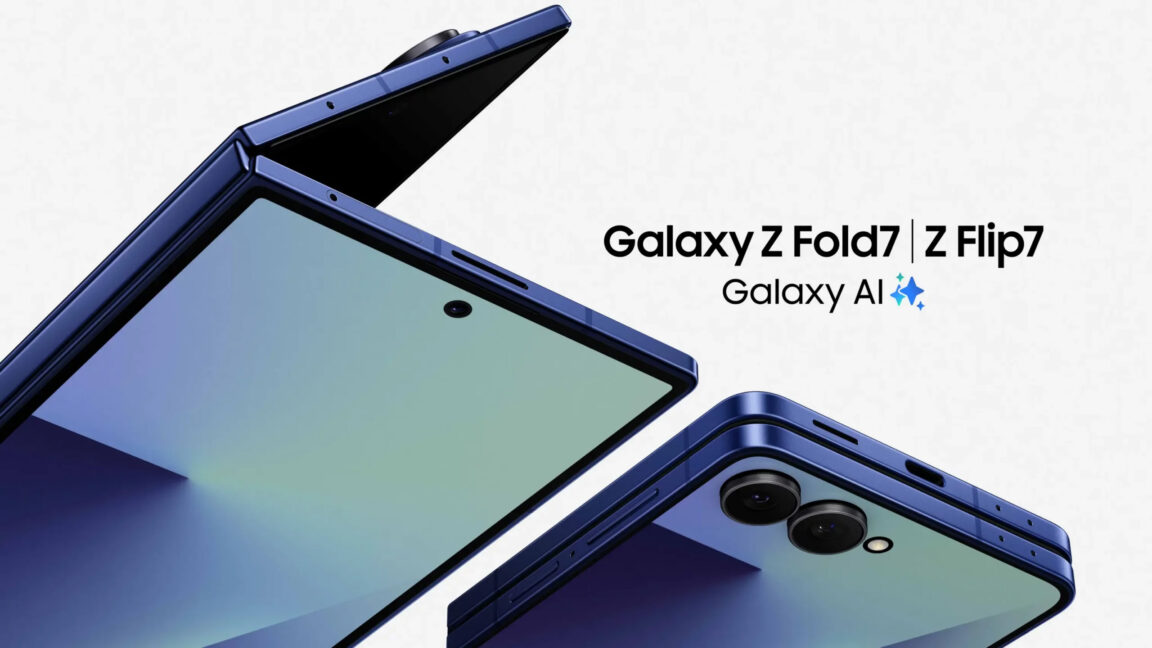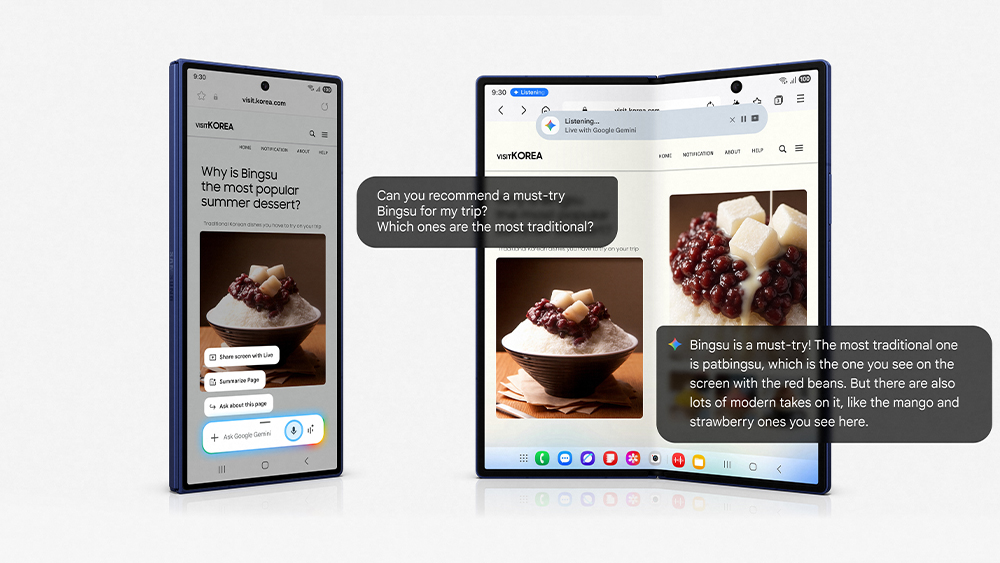
Credit: Samsung
There's no denying annual smartphone releases have settled into a routine—flat glass slabs with slightly faster processors and better cameras. Foldable phones buck the trend, but these products come with plenty of drawbacks. They're big and heavy, and even with all that bulk, the battery life and cameras can be lacking.
Samsung's new Galaxy Z Fold 7 and Z Flip 7 don't right all the wrongs, but they mark the most significant year-to-year upgrade since the company began making foldables. The new phones are thinner and lighter, particularly in the case of the Z Fold 7, which is even lighter than the Galaxy S25 Ultra. You will pay handsomely for Samsung's new foldable flagship, but it's also releasing a new budget FE version of its flip phone as well.
One big fold
Samsung has been making foldable phones longer than anyone, but the changes from one generation to the next have been minimal. Its seventh-generation foldables make the biggest leap yet, responding to a new spate of thinner foldables from Google, Oppo, and others. That's really the biggest innovation for the Galaxy Z Fold 7—it's slimmer and a bit wider.
When closed, Samsung's larger foldable is 8.9 mm thick, which is only a little more than the Galaxy S25 Ultra and much less than the 12.1 mm of the Galaxy Z Fold 6. When open, it's just 4.2 mm. That's even thinner than Google's Pixel 9 Pro Fold and barely more than the height of the phone's USB-C port. Despite the thinner profile, Samsung maintained the same 4,400 mAh battery, which it claims is good for "all day" use. That might be true, but using the larger internal screen will drain the battery faster and could leave you looking for a charger in the evening.
The form factor tweak delivers a more common-sense display setup. The cover display is a 6.5-inch, 120 Hz OLED at 1080×2520, which is a 21:9 ratio. This is in the realm of normality for flat, non-folding phones. So, you can use the Z Fold 7 closed without worrying about apps rendering weirdly on a too-narrow screen as with past versions of this phone. Open the phone up, and you get a new, larger 8-inch, 120 Hz OLED at 1968×2184. One unfortunate drawback of the design change is that Samsung has dropped support for the S Pen stylus from the Z Fold 7.
The Galaxy Z Fold 7 is much thinner and lighter than past models.
Credit: Samsung
Samsung says part of the big Z Fold redesign is a new "Armor Flex" hinge, which is flatter and stronger. It also allows for a "teardrop-style" fold in the flexible display, which should reduce the appearance of the crease—it's still visible on this phone, though.
Inside, the Fold 7 has the fastest mobile processor on the market, the Galaxy-enhanced Snapdragon 8 Elite. This is the same chip used in the Galaxy S25 family. It starts at 12GB of RAM, which is a bit of a disappointment. If you want 16GB, you'll have to get the most expensive 1TB version of the phone.
The camera array is a big step up for the Z Fold line, which has traditionally trailed the company's high-end flat phones. The Z Fold 7 finally gets a 200 MP main sensor to match the Galaxy S series. It's joined by a less impressive 12 MP 3x telephoto and a 12 MP ultrawide. The latter has autofocus for macro shots, though. There's also a 10 MP selfie camera on the cover and another inside. However, the inner selfie camera no longer uses Samsung's under-display technology—it's just a hole-punch design.
Samsung's new tablet-style foldable may finally be comfortable to use.
Credit: Samsung
It's not all good news. The various upgrades have pushed the price higher than last year's Z Fold. The new version will run you $1,999, but Samsung offers generous trade-in credits for its last-gen phones. That can bring the price down to $1,000. Preorders are live today, and the phone will ship on July 25.
Two little flips
Samsung is giving the Z Fold 7 top billing right now, but new flip phones might steal the show. Yes, there are two flip phones this year, including the budget model rumored for the last couple of years. Size wasn't really the issue with past Z Flip devices, but the new model still shaved off a few millimeters. The Z Flip 7 will clock in at 6.5 mm thick when open and 13.7 mm when closed. The Flip 6 was 14.9 mm thick. Samsung notes the new hinge is more durable even when it takes an impact, an apparent reference to some older Z Flip phones that would stop opening properly when dropped on the hinge.
The Galaxy Z Flip 7 gets a bigger cover display and slimmer frame.
Credit: Samsung
The internals will diverge from past Samsung lineups. Instead of a matching Qualcomm processor like we have in the Z Fold 7, the Flip 7 will have a Samsung Exynos 2500. This is a 3 nm Arm chip that is theoretically in the same league as the Snapdragon 8 Elite, but it's brand new, and its performance is uncertain right now.
The most notable physical upgrade is the larger cover display, which takes a page from Motorola's Razr playbook. The screen now covers the entire front of the phone, with cutouts for the two main cameras. The external 120 Hz OLED measures 4.1 inches at 948×1048. The internal folding display has gotten a little larger, too. It has grown from 6.7 inches to 6.9 inches, with a 1080×2520 resolution. This is the same 21:9 ratio as the cover display on the Z Fold 7.
The cameras haven't been changed from last year despite the redesign. This phone still gets a 50 MP main sensor with a 12 MP ultrawide. There is a 10 MP selfie camera at the top of the inner display, but the larger cover display makes it even easier to use the main cameras to take selfies.
Samsung maintained the Z Flip 7's price compared to last year's model. It starts at $1,099 for 256GB of storage and 12GB of RAM. If that's too much, Samsung has another Flip this time. The Galaxy Z Flip 7 FE retains the thicker last-gen design, but it comes in at a lower $899 price. Both flip phones are up for preorder now and will ship on July 25.
The Galaxy Z Flip 7 FE keeps last year's foldable design.
Credit: Samsung
Like last year's flagship flip phone, the Z Flip 7 FE has a 6.7-inch internal screen and a 3.4-inch cover display with a large cutout around the camera sensors. While the internal screen is a respectable 1080×2640, the cover is a mere 720×748 pixels, and it only refreshes at 60 Hz. The FE does have the same camera setup as the more expensive flip phone, at least.
Samsung also saved some money on the internals. The Z Flip 7 FE runs on the older Exynos 2400, which is a 4 nm chip. This phone is only offered with 8GB of RAM and either 128GB or 256GB of storage. It's not going to set speed records, but this is the first time Samsung has released a cheaper flip phone. Motorola has been offering foldables in this range for a few years, though. And just $200 more gets you the much more capable Samsung flip phone.
Android 16 and more AI on board
The benefits of Google's revised Android release schedule are becoming clear. Samsung confirmed the new foldables will launch with Android 16 and One UI 8, which is the fastest rollout ever for Samsung. Like other recent Samsung phones, the company is promising seven years of Android updates. Those updates probably won't all arrive as promptly, though.

Credit: Samsung
Samsung is sticking to its AI guns. The new devices will include a raft of AI capabilities, and buyers will get six months of Google's AI Pro subscription for free. That's less than the year you get with Pixels, but Gemini is more integrated with Google's phones. Many of Samsung's AI features are connected to its custom Galaxy AI system.
Samsung's Now Bar is still at the core of its AI efforts. As part of Galaxy AI, Samsung uses on-device intelligence to process data from your apps in a secure way. These insights feed into the Now Bar, which is supposed to include useful summaries and suggestions. In One UI 7, the Now Bar was rarely useful, including little more than weather and calendar appointments. Samsung is promising more insights going forward. For example, the phones could recognize that you're going on a trip and recommend downloading language packs or finding activities at your destination. The company says its new phones are "true AI assistants." Samsung made similarly lofty promises about the last version of Galaxy AI, though.
While the utility of generative AI models on mobile devices is still questionable, Samsung's approach of on-device processing is preferable to what many other companies are doing. You can expect to see more of these features roll out as these phones are updated over the coming years.

-
 C114 Communication Network
C114 Communication Network -
 Communication Home
Communication Home


